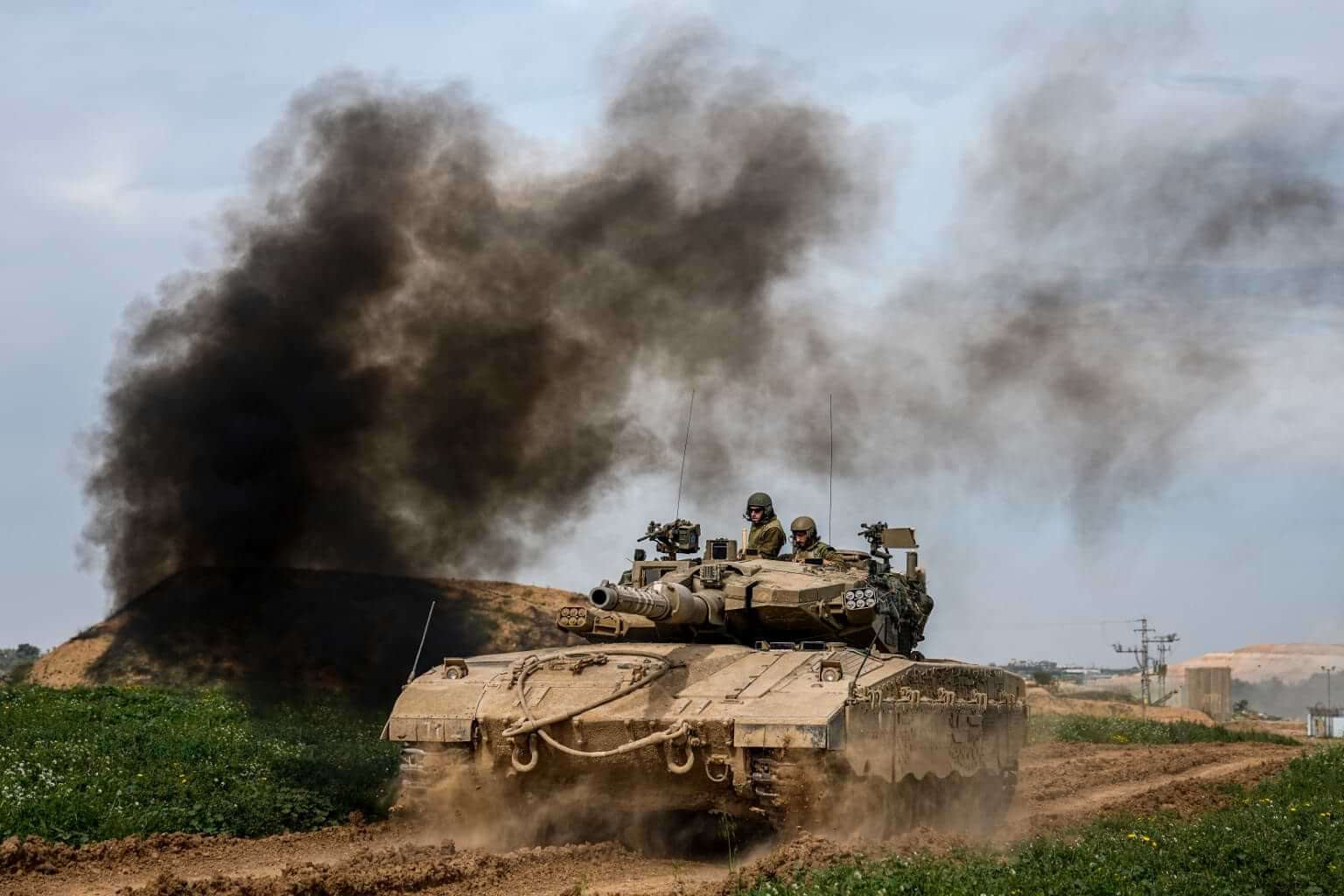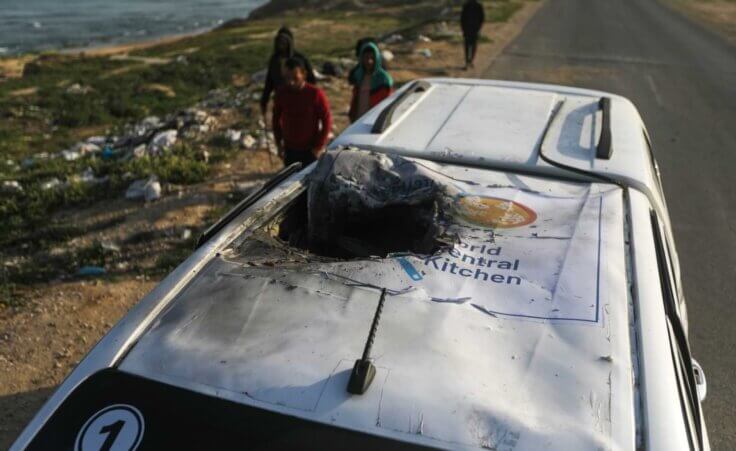
Israeli soldiers drive an tanks on the border with the Gaza Strip, in southern Israel, Tuesday, Feb. 13, 2024. The army is battling Palestinian militants across Gaza in the war ignited by Hamas' Oct. 7 attack into Israel. (AP Photo/Ariel Schalit)
When I published The War in Israel: What You Need to Know about This Crisis of Global Significance in November 2023, we knew the conflict would continue long past the book’s release. As a result, we published the resource digitally so we could easily issue revised editions that would update its content.
This February 2024 appendix is the first such revision. Rather than rewriting the book, it seemed more straightforward to add content as appropriate.
What follows is:
- an update on the conflict across recent months,
- an analysis regarding Israel’s failure to stop the invasion,
- an explanation of the Houthis and their threat to global commerce,
- and some closing observations on the continuing conflict.
NOTE: This article is an update to The War in Israel series. A free ebook is also available here.
What is the status of the war?
The New York Times reported on February 25, 2024, that “the Israeli military, by its assessment, has delivered a major blow to the capabilities of Hamas, killing commanders, destroying tunnels, and confiscating weapons.” However, their goal of destroying Hamas “remains elusive.”
The IDF estimates that it has killed more than ten thousand militants and dismantled the command structure of eighteen of Hamas’s twenty-four Gaza battalions. They have killed commanders, deputy commanders, and other officers, effectively rendering these units ineffective.
However, thousands of Hamas fighters, attached to remaining battalions or operating independently, remain below and above ground. Hamas’s representative in Algeria said in February, “The resistance is still able to inflict pain on the enemy.”
The Israeli military estimates that at least five thousand militants remain in the northern part of Gaza, a small but formidable force capable of launching rockets into Israel and attacking ground troops. Hamas forces are hiding in their extensive underground tunnel network in and around Khan Younis to the south, one of the most significant centers of their military activity.
At this writing, the IDF are anticipating a battle for Rafah, the southernmost city on the border with Egypt, where roughly ten thousand Hamas fighters remain in a city where about one million Palestinian civilians are sheltering.
Hamas believes that if any meaningful amount of their military strength survives the war, this will represent victory. Accordingly, Israeli security officials anticipate a prolonged campaign to defeat Hamas.
“Is it possible this mission will be left for my children?” one official asked. “The answer is yes.”
Meanwhile, tensions are rising with Hezbollah to the north. The IDF said on February 26, 2024, that it had conducted strikes in Lebanon’s Beqaa Valley for the first time. This area is known as a stronghold of Hezbollah, Lebanon’s Iran-backed Shia militia and political party that supports Hamas. Previous attacks have been largely limited to the border between Israel and Lebanon; the strike marks what a Lebanese security source called a “broadening of Israel’s campaign.”
Why did Israel not stop the October 7 invasion?
Hamas’s terrorist invasion on October 7, 2023, was the worst single loss of life for the Jewish people since the Holocaust. Since that time, many have asked how this happened. The IDF had been patrolling the border with Gaza through electronic and human surveillance. Many in Israel thought they were building bridges for rapprochement with Hamas through humanitarian assistance and political initiatives.
Now we know that Hamas had been planning this invasion all along—for decades, in fact.
Dr. Mark Turman and I recently conducted a podcast with Dr. Mike Fanning, our longtime tour organizer in Israel, and Reuben Nevo, one of our tour guides. We have worked with both men for three decades; I count them among my closest friends. I encourage you to listen to the entire podcast here.
In talking with Reuben, who lives in a town located between Jerusalem and Tel Aviv, he explained that the Israelis now know that they have been living under the “wrong concept” with Hamas over these years. They thought Hamas was making progress toward peace and a two-state solution, and they thought the IDF could protect Israel if Hamas invaded. Now they know they were wrong on both counts.
How did they make such a tragic miscalculation?
I found Ariel Levite’s article, “How Was Israel Caught Off-Guard,” to be very perceptive and informative in this regard. Levite is a senior Fellow at the Carnegie Endowment for International Peace and author of the Columbia University Press publication, Intelligence and Strategic Surprises.
I’ll summarize his extensive analysis with these points:
- Hamas’s extensive preparations for the invasion were interpreted by Israel as intensified training exercises rather than an attack in the making.
- Israel had significant technological intelligence but lacked human intelligence (spies and informants) by which to assess Hamas’s intentions.
- They underestimated Hamas’s capacities, viewing them as a second-tier terrorist or paramilitary organization (especially in comparison to Hezbollah), hardly capable of launching a sophisticated attack against IDF’s superior capacities.
- Israel was also focused on developments in the West Bank, Lebanon, Syria, and Iran.
- Deception by Hamas may have played a role along with the crying wolf syndrome: Israeli intelligence had earlier warned of a possible attack on April 23 that Hamas then canceled, apparently realizing that its plans had been compromised.
- Hamas timed the attack for the Sabbath, when many active-duty units are typically on home leave.
- Israel placed too much trust in the billion-dollar high-tech fence it had erected on the border with Gaza.
- Israeli leaders believed Hamas’s leaders were motivated primarily by self-preservation and greed and could be controlled through work permits and regular Qatari cash infusions.
- Relations between the prime minister, the defense minister (whom he unsuccessfully tried to fire), and the security establishment had grown deeply toxic.
- Prime Minister Netanyahu saw Hamas’s hostility toward Israel and its rivalry with the Palestinian Authority as a helpful bulwark against pressures to negotiate the formation of a Palestinian state.
Levite closes with what he calls his “biggest takeaway”:
In final analysis, governments should periodically revisit their precise expectations of warnings from the intelligence community to ascertain that these are not only realistic but also adjusted to changing circumstances and policy priorities. They should recognize the ever-present risks of relying on intelligence at the expense of planning for unexpected scenarios. Most policymakers would rather not worry about threats that their intelligence services view as unlikely. Prediction and estimates should not supplant preparedness, as they will inevitably lead to occasional failure. Some, perhaps subconsciously, are eager to have intelligence as a convenient scapegoat should debacles occur. But it falls to policymakers to realize that intelligence is always imperfect. For this reason, prediction should never take the place of preparedness.
This warning remains relevant as the conflict continues.
Who are the Houthis? Why are they a threat to global commerce?
A threat has risen to the US and global commerce from a group you probably heard little about until recently: attacks by the Houthis have targeted commercial vessels in the Red Sea, disrupting commerce and inflicting significant financial pain for Israel and the West.
Who are the Houthis? How much of a threat are they to Israel and the US? The answers are troubling for the region and are contributing to the growing prospect of global war.
Yemen, the Arab world’s poorest nation, is a country of twenty-eight million people on the southern end of the Arabian peninsula. In the 1990s, the Houthi movement emerged in the northern part of the country in reaction to rising Saudi financial and religious influence. Their name comes from the surname of the movement’s early leader, Hussein al-Houthi, who died in 2004.
The Shiite group, backed by Iran, has been fighting Yemen’s Sunni-majority government for two decades. They control the capital city of Sanaa and much of the western part of the country. They have been protesting the IDF’s post-October 7 incursion into Gaza by targeting ships headed toward Israel as well as US forces in the area.
Conclusion: What comes next?
There are three broad scenarios in view regarding Israel’s war with Hamas.
- Israel is able to degrade Hamas’s capabilities in Gaza to such a degree that the terrorist organization is no longer an existential threat to the Jewish state.
- Two: Israel is unable to remove Hamas’s operational capabilities in the short term, meaning that the conflict will persist for the foreseeable future.
- Israel is able to win enough of a military victory to return the nation to a tenuous peace with regard to its western flank, but the “idea” of Hamas persists as an ongoing threat to the nation’s ultimate survival.
These scenarios are made much more complex by the other questions in the region:
- Will the Houthis be able to continue their aggression against shipping in the Red Sea region, or will the coalition amassed against them end their military threat?
- Will ongoing Israeli settlements in the West Bank provoke an intifada (“uprising”) that leads to another war, this time on Israel’s eastern border (including the eastern half of Jerusalem)?
- Will other terrorist groups, such as Islamic Jihad, escalate their aggression to a significant and damaging degree in Gaza and the West Bank?
- Will Iranian proxies in Syria and Iraq rise to become existential threats from the northeast?
- And perhaps most significantly, will the skirmishes with Hezbollah lead to another all-out war such as last occurred in 2006? Hezbollah is estimated to possess 150,000 missiles, many of which can reach deep inside Israel, as well as an extensive air-defense system and a commando force.
Add the ongoing internal conflicts between rival political parties and visions for Israel’s future and it is unsurprising that Haaretz would call 2023 “Israel’s Worst Year Ever.”
It is not difficult to imagine a scenario by which Houthis in the south combine with Hezbollah in the north, Palestinian Islamic Jihad in the West Bank, and Hamas in Gaza to form a four-front assault against Israel. All four are proxies of Iran, which has long sought Israel’s destruction. They could not realistically defeat the IDF, but their incessant attacks could discourage Israelis and prompt them to abandon their nation.
In such a scenario, the US would likely need to escalate its military support for Israel. This at a time when Ukraine is seeking additional support for its ongoing war with Russia. If China were to invade Taiwan, the US would find itself on the other side of yet a third global conflict.
According to A. Wess Mitchell, senior advisor for the United States Institute of Peace and a former assistant secretary of state for Europe and Eurasia, this is the worst-case scenario for the US. He writes in Foreign Policy that our military is not designed to fight wars against two major rivals simultaneously, much less three. We would fight such a world war as “a thinly stretched US military alongside ill-equipped allies that are mostly unable to defend themselves against large industrial powers with the resolve, resources, and ruthlessness to sustain a long conflict.”
Mitchell believes that waging such a global war “would require a scale of national unity, resource mobilization, and willingness to sacrifice that Americans and their allies have not seen in generations.”
As we pray for the Jewish people and their Arab neighbors to find true and lasting security for their peoples, let us “pray for the peace of Jerusalem” (Psalm 122:6) with renewed commitment today.














